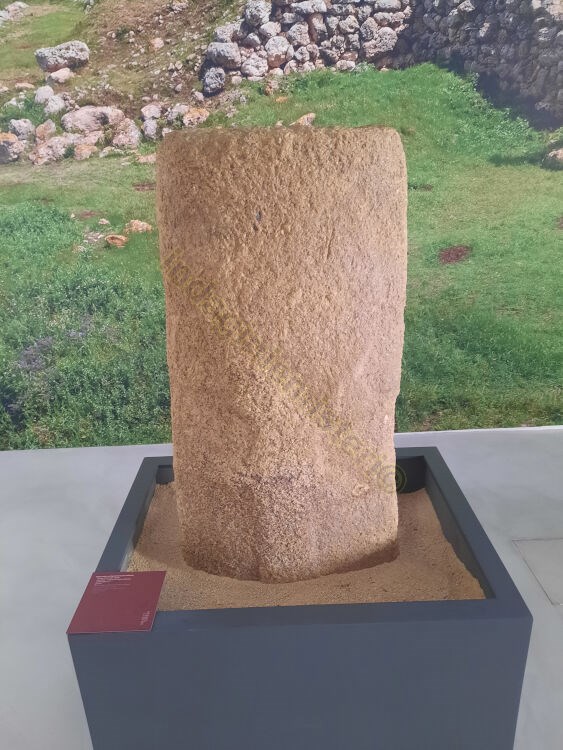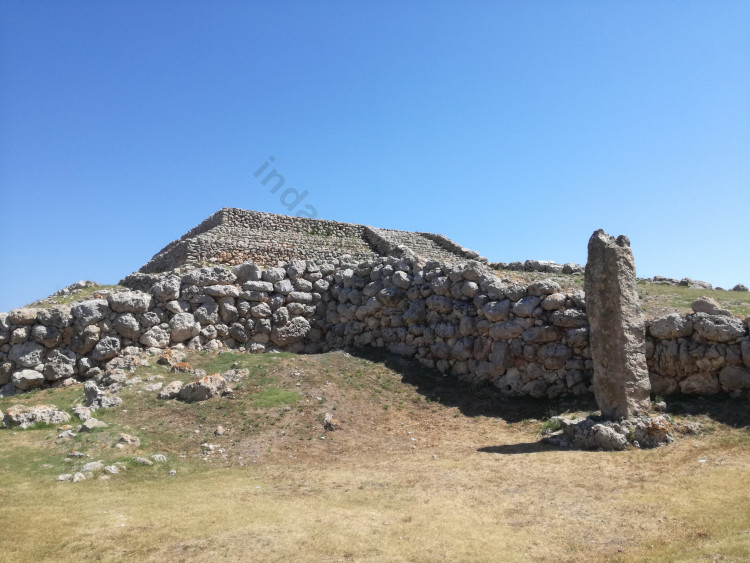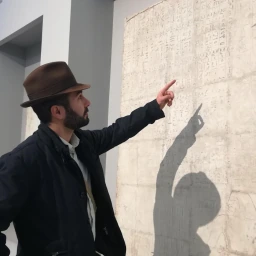At the beginning of the third millennium B.C., at Monte d’Accoddi, someone raised his eyes to the sky. And, in the light of the night, he saw in the firmament the divine image of the mother, the Great Goddess, generator and nurturer of the Universe. Like the beings on earth, the stars had their own time too, then were reborn to new life and the morning light dispelled the darkness. The mother goddess bore all things in her womb ,of the earth as well as the cosmos. She guaranteed the continuity of natural cycles, she established the time of life and death.
Here is the manifestation of unprecedented cultural expressions, an arcane reflection of new conceptions of the world and the divine. Ancient Sardinians of the Ozieri culture were the first to elevate the ritual towards the heavens, they definitely detached themselves from the mere stone, which had accompanied every sacred manifestation in Sardinia, and did so again in the following millennia. This phase of change took concrete form in the realisation of innovative cultic architectures. Not far from Sassari, a sanctuary was erected facing the sky, a high place similar to the Mesopotamian ziggurats1: the sanctuary of Monte d’Accoddi was accessed by a steep ramp, and sacrifices to the divinity were officiated on its monumental altar. The goddess of Sardinia, the female archetype that regenerates everything, then became mother of the earth and owner of the sky2.

The discovery of the sanctuary of Monte d’Accoddi
That hill located eleven kilometres from Sassari, the only high ground in the flat Nurra, had raised more than a few suspicions. Everyone agreed that it was an artificial mound of soil and stone, but there were different hypotheses as to what lay beneath. For Antonio Segni, at the time Minister of Education, who could see the hill from his property, it was a large burial mound like the Etruscan ones. It was he who had financed the excavation projects at Monte d’Accoddi, convinced of finding tombs and grave goods there.
Ercole Contu was not convinced: for him, that little mound concealed nothing more than yet another nuraghe, similar to the other seven or eight thousand found in Sardinia3. However, when the excavations began, it was revealed that they both had been mistaken. Indeed, what lay beneath the hill of Monte d’Accoddi could not even be imagined. It was something totally other from what archaeology had so far discovered on the island.
Excavations carried out by Ercole Contu (1952-1958) revealed a monument from the pre-Nuragic period, older than the known nuraghi by at least one thousand and six hundred years. It was an unusual architecture, made of soil and rubble, that probably had no sepulchral function. In fact, there was no access to hypogeic chambers along the perimeter, as in the domus de janas, for instance. Ercole Contu writes that, “it was instead an embankment, delimited by a simple rough wall, made to support an altar, on which rites were in some way celebrated”4. An ancient sanctuary was discovered at Monte d’Accoddi.

Sanctuary of Monte d’Accoddi
The building had the curious shape of a truncated pyramid, contained by banks of limestone blocks. The upper platform (approximately 38 m x 31 m), also called the “altar” by analogy with the Mesopotamian Ziggurat, was reached from the south side via an inclined ramp, approximately 42 metres long. Surrounding the construction were discovered the foundations of a village, numerous female statuettes, a menhir in a reclining position on the west side of the structure and, on the east side, two slabs used for ritual sacrifices, as attested by the animal bones found (cattle, deer, sheep pigs).

One of them, made of limestone, was carved to make numerous cup-marks and had seven holes at the edges to hold the victim’s ligatures. The blood was then drained to the ground through a natural swallow hole. These are important clues, allowing us to partially understand the cultic function of the sanctuary of Monte d’Accoddi: there, the mother goddess received offerings from the community, aimed at propitiating the rebirth of life.
The Lady of Heaven
With the construction of the ramp and the terracing, however, there is an absolute novelty: an elevated place is created, facing the sky, where the presence of the divine is sought. The building welcomed that particular conception of the mother goddess as the Lady of Heaven, and represented the focal point of the entire cultic complex. Indeed, the two stele statues found near the monument refer to this divinity: one, in granite, shows a stylised female figure5; the other, limestone and fragmentary, was sculpted with spirals, a recurrent motif in domus de janas known as the “Goddess of the Eyes”.


On the upper altar of the sanctuary of Monte d’Accoddi was thus a rectangular sacellum, at which, it is assumed, sacrifices were carried in procession along the ramp. The ceremonies were certainly accompanied by ritual dances, which can be deduced from the finding of a neck jar on site.
The earlier altar
Ercole Contu had excavated the entire perimeter of the monument: the absence of openings suggested that there were no interior rooms. However, about twenty years later, a new excavation campaign was initiated to investigate the deeper layers of the embankment. This analysis, made possible thanks to improved technical tools for archaeological investigation, was conducted by Santo Tinè of the University of Genoa between 1979 and 19896. Professor Tinè was still convinced of finding, under the great mound of soil of the Sanctuary, the burial place of some illustrious ancient Sardinian. He therefore excavated up to the base of the monument, to a depth of eight metres.
Once again, however, expectations were betrayed: the archaeologists found no tomb but other unexpected twists. Santo Tinè discovered that the lower layers consisted of a peculiar coffered structure that, by rows of stone, delimited defined portions of land. Most importantly, he found the remains of a pre-existing and now buried building, very similar to the one discovered by Contu, but smaller and older. This earlier altar, with a truncated pyramid shape and access ramp, probably existed already at the beginning of the 3rd millennium B.C., under the late phase of the Ozieri culture (3200-2900 B.C.)7.

The red temple
Even more exceptional was the discovery on the platform of portions of the floor and the perimeter wall belonging to the original sacellum. Some dig post holes indicated the presence of a portico and perhaps a double-pitched roof. Santo Tinè had discovered the first true cultic centre of Monte d’Accoddi. The sacellum, surprisingly, revealed traces of colour: at the time of its use, it was probably entirely sprinkled with ochre, and is known today as the “red temple”. The use of this particular pigmentation was not accidental. Red ochre, in Sardinia as in many Neolithic societies, simulated the presence of blood – the vital principle of human beings – and had the same symbolic value.
Around 2800 B.C., however, when the area of Monte d’Accoddi was colonised by the people of the Filigosa culture, a fatal event probably occurred. Archaeologists have found traces of combustion: it is possible that a fire devastated the red temple. The structure was then covered with soil and rubble to form the altar that is visible today, still in the shape of a truncated pyramid but placed higher and larger than the original one. Consequently, the ramp also became longer.
The sanctuary of Monte d’Accoddi as axis mundi
At that time, the ancient Sardinians used to bury the dead in a foetal position and cover them with red ochre to recall the first image after birth, so as to guarantee a new birth in the afterlife. It is possible that the sanctuary of Monte d’Accoddi was an expression of the same way of conceiving reality, but in a broader, almost cosmic, sense. The ritual sacrifices carried out on the altar were meant to propitiate not only the rebirth of the individual through Mother Earth, but of the entire universe, to allow the continuity of agricultural cycles and soil fertility, which depended on the stars8. The monument had the function of connecting humanity’s perspective to the heavens, thus assuming the role of axis mundi between different dimensions.

The omphalos of the sanctuary of Monte d’Accoddi
The sacellum on the sanctuary of Monte d’Accoddi expresses the concept of the Sacred Center, which we already find in the meaning of the mountain, natural or artificial, in numerous ancient cultures. It is a place of encounter with the divine, a privileged space where the transcendent manifests itself. Not dissimilar in meaning to the Omphalos of Delphi, a large spheroidal stone was found just beyond the archaeological site, which today stands next to the ramp9. The boulder, made of sandstone and on whose surface small cup-marks were carved, was also a cultic object; it probably served as a marker of the sacred place. Close to the omphalos was another spheroidal stone, made of quartzite. The geometry, sought through careful stonework, expressed beliefs about the cyclical nature of the cosmos and life.

For all this evidence, the cult complex of Monte d’Accoddi marks perhaps the highest stage of the pre-Nuragic civilisations10. To date, nothing else similar is known in Europe or in the Mediterranean area. The Nurra Sanctuary had a great sacral significance and attracted worshippers from all over Sardinia.
The village of Monte d’Accoddi
Near the sanctuary of Monte d’Accoddi, archaeologists have discovered the remains of several dwelling settlements, which existed over time. The earliest evidence dates back to the time of the San Ciriaco culture (3500-3300 B.C.), when the altar did not yet exist, but the cultic centre consisted at most of only the menhir and a few lithic slabs for sacrificial offerings. The frequentation of the area in this period is reflected in the extensive domus de janas necropolis in the surroundings.

However, the most evident archaeological evidence belongs to the late phase of the sanctuary of Monte d’Accoddi. They are referable to the Filigosa facies, and its peculiar evolution named Abealzu (c. 2700 BC)11. Only the foundations of several huts remain from this village, single-row huts with dry-stone walls. Famous among them is the “wizard’s hut”, with a trapezoidal floor plan, so called because of some curious objects kept in it, such as shells and a bovine horn tip. The dwelling has yielded hundreds of archaeological finds in stone and terracotta, providing a snapshot of the daily habits of the Abealzu Sardinians. The different rooms housed a fireplace, on which there was still a tripod, a pantry and some weaving tools.

The sanctuary of Monte d’Accoddi was occasionally frequented in the Bronze Age, when the ancient rituals were no longer practised. We find evidence of a different use of the area in the burial of a child, attributable to the Bonnanaro Culture (1800 B.C.), the last guardian of the axis mundi, a sacred place now lost.
Samuele Corrente Naso
Notes
- E. Contu, L’altare preistorico di Monte d’Accoddi, Guide e Itinerari, 29, Carlo Delfino editore, Sassari 2000. ↩︎
- G.Lilliu, Simbologia astrale nel mondo prenuragico, in Atti dei convegni Lincei, 2001. ↩︎
- Ibidem note 1. ↩︎
- Ibidem note 1. ↩︎
- A. Moravetti, Gli altari a terrazza di Monte d’Accoddi, in Darwin Quaderni. Archeologia in Sardegna, 2006. ↩︎
- S. Tinè, Monte d’Accoddi e la cultura di Ozieri, in La cultura di Ozieri. Problematiche e nuove acquisizioni, Ozieri, gennaio 1986-aprile 1987, ed. Ozieri, 1989. ↩︎
- Ibidem notes 1 and 5. ↩︎
- Ibidem note 2. ↩︎
- Ibidem note 6. ↩︎
- Ibidem note 1. ↩︎
- Paolo Melis, La religiosità prenuragica. Nel volume: A. Moravetti, P.Melis, L. Foddai, E. Alba, La Sardegna Preistorica, Corpora delle antichità della Sardegna, 2017, Carlo Delfino editore & C. ↩︎


